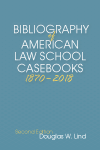BIBLIOGRAPHY OF AMERICAN LAW SCHOOL CASEBOOKS, 1871-2018 2ND EDITIONLind, Douglas W. Item #: 1000256 ISBN: 78-0-8377-4113-0 Published: Getzville; William S. Hein & Co., Inc.; 2020. Subjects: BIBLIOGRAPHY, LIBRARIANSHIP, LEGAL EDUCATION In 1871, at Harvard Law School, Christopher Columbus Langdell introduced the "case method" of legal instruction, which is today used in some form or another in every law school in the United States, meaning that casebooks remain the primary vehicle of legal education. This bibliography presents a comprehensive list of casebooks intended for use in law schools and published in the United States from their inception in 1871 through 2018. The entries are arranged into more than 200 broad subject categories, and then are listed chronologically within each subject category. Arranging the titles in this format provides a basis for tracing the topical development of legal education and the case method of instruction. Much has changed in the landscape of law school casebook publishing since the publication of the first edition, which covered titles published from 1870–2004. However, despite predictions of their imminent demise, print casebooks have persisted. In an age of preference for, and seemingly immediate access to, information in a digital format, it is surprising that new editions are being produced at a faster rate than ever before, and although digital and open-source titles have made inroads, they are not replacing print. As a matter of fact, the number of print titles has steadily increased every decade for the last 40 years. Additionally, the content of the casebook has changed over the years. The days of Langdell’s collection of cases with little explanatory text are gone. Law professors have begun writing treatise-like “casebooks” containing few actual cases, and publishers have increasingly been marketing traditional academic titles to a broader audience to include practitioners and scholars. As a result, the definition of “casebook” has become increasingly murky, thus making the upkeep of this bibliography even more difficult. Although the casebook as we currently know it will likely change in the coming years, this bibliography demonstrates that it remains a mainstay of legal education. The online version, which will be updated regularly, contains all the bibliographic records from 1879 to 2018 as listed in the book, and allows browsing by subject, author, title, publisher or series, as well as searching by the same options plus keywords.
|
